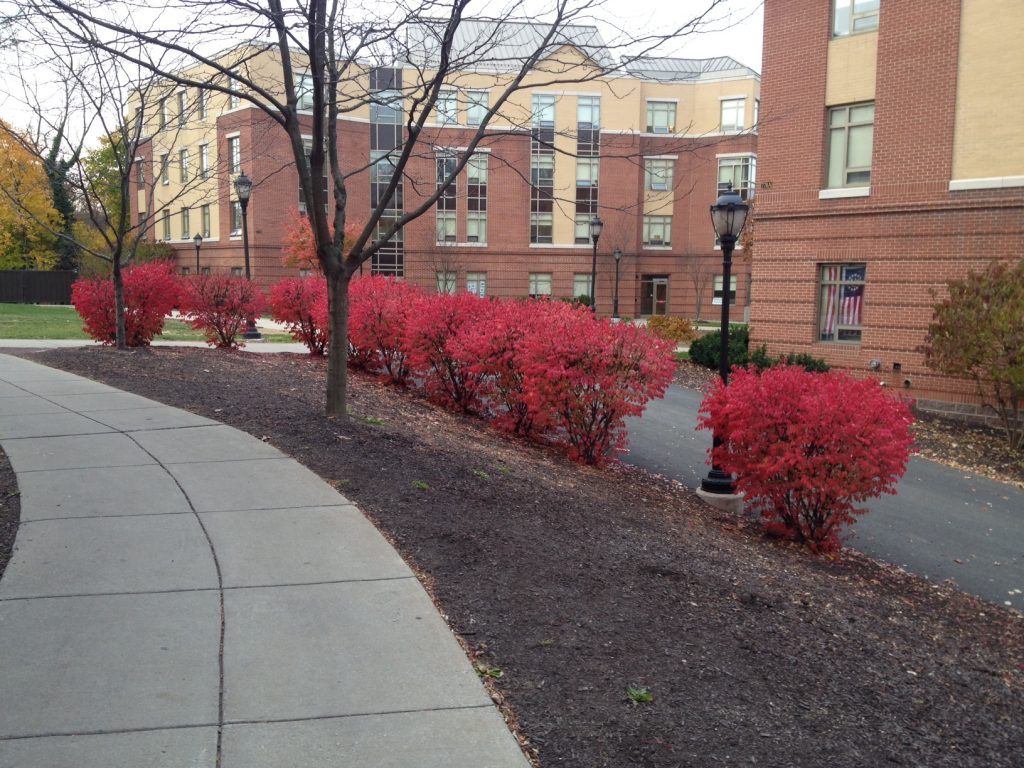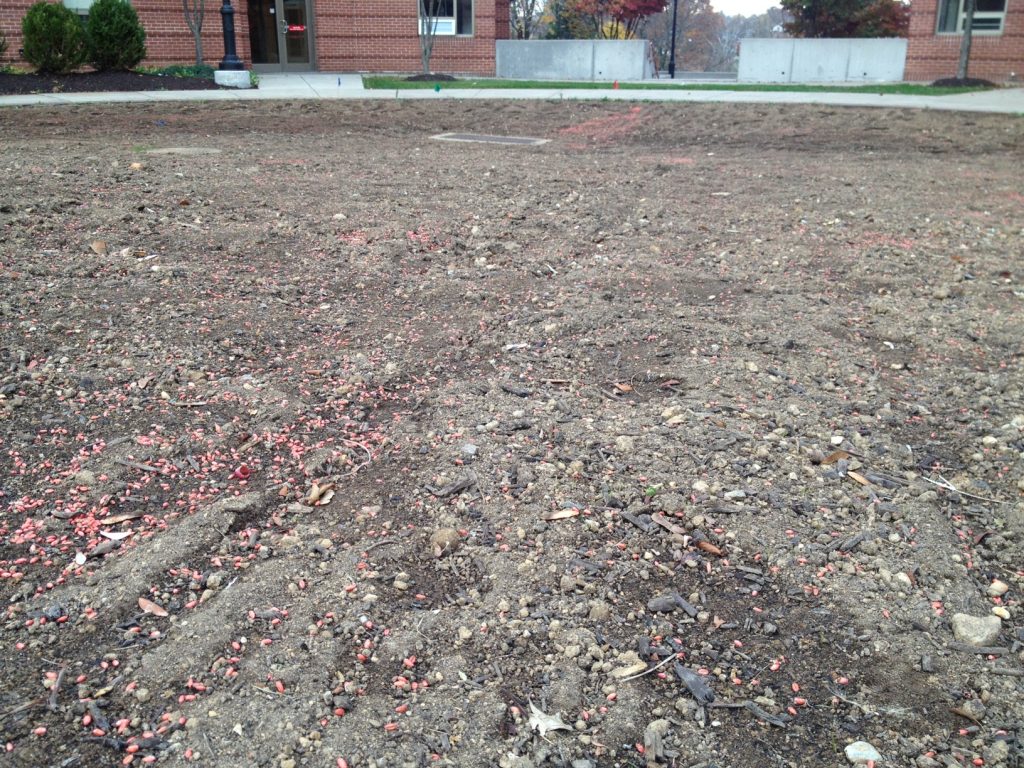We’re on the Morning Call! I’m only a little bit bitter that the picture of Alaina, Prisca, and I attempting to dig a hole didn’t make the cut…
College campus powered by wind!
A friend that I made abroad shared this link today about her college. Similar size to Lafayette and fully embracing wind power in campus- I think it is so inspiring. Their transition to renewables has them “avoiding 7,000 tons of carbon dioxide emissions each year, or the equivalent of taking more than 1,300 cars off the road yearly”.
So awesome.
http://strib.mn/2gaV63B
The future of roofing?
I saw this a couple of weeks ago and thought that I would share. The future is cool.
http://www.solarcity.com/residential/solar-roof
Some landscaping pics from this morning

Butterfly weed going to seed in the pollinator garden at AEC

A lovely row of burning bush. Listed as an invasive species by PA DCNR.

Winter wheat has been seeded at Fisher Quad – thanks Dave K!
3rd Street dam

Early November morning at the Bushkill dam
This will be gone in a couple years – imagine the possibilities…
Our Roles Have Changed
Our projects may be at the point where we’re zoomed into the details, but the outcome of this election has forced us to zoom out. President Elect Trump has already announced that the Keystone XL Pipeline will be constructed, the rest of our coal reserves will be mined and burned, and all contributions from the United States to global climate mitigation will end. The outcome of Tuesday’s election resulted in the worst possible scenario for the environment. We face an unexpected and potentially catastrophic situation. Now, we must to reassess our roles and motivations as environmentalists as we craft our proposals for the end of the semester as well as our life plans for the end of next semester.
I have had three profound thoughts regarding this reassessment that I would like to share with you all:
- Our role as avoiders of climate disaster has just shifted to adapters to climate disaster. If the Trump administration follows through with the aforementioned actions – a likely situation given the glaring red which now characterizes our federal government – fossil fuel emissions will increase rapidly. Climate change is happening and, during the next four years, will progress at a rate faster than “business as usual.” Think back to Lawrence’s Climate Change class. You know what this means – the worst case scenario. How will we make the market for renewable energies such that cheap gas and coal doesn’t dominate? How will we protect endangered species given altered seasons and rising sea levels? How will we house climate refugees from our coast, our deserts, and all over the world? How will we ensure that our agriculture remains in enough intact to feed the increasing number of mouths? These are the questions that the world is counting on us to answer. They are daunting and numerous, but this is the reality of a Trump presidency.
- Our fight must be constant and broad. Every four years is not nearly enough. Buying LED lights and going vegetarian is no longer enough. Donating a few dollars after a major oil spill or environmental disaster is not enough. We can no longer count on our federal government to do the heavy lifting. We must work tirelessly to create an infrastructure separate from our federal government that promotes renewables, energy conservation, greenhouse gas mitigation, conservation of species, etc. Work with your cities and states to adopt climate policy, incentivize renewable development and mandate energy conservation. Pressure your future employers to strive for carbon neutrality. Make donations to WWF or Conservation International in lieu of holiday gifts. Spend your free time volunteering with one of many environmental and social justice organizations. Our social norms and comfortable routines no longer take priority over this fight.
- The fight for our earth cannot operate in isolation from other progressive fights. I hope that everyone understands this by now, but I emphasize it because this is more important now than ever. The right to a clean, safe, healthy environment is a human right. The right to marry whomever you love is a human right. The right to living through a police encounter is a human right. The right to feel as though you can leave your home without fearing assault, abuse, discrimination, or death is a human right. All of these rights, that should be characteristic of a civilized society, are currently at risk. The fights for these rights do not exist in vacuums. We cannot protect any of these rights without fighting to protect them all. I urge you to open lines of communication with activists fighting for all of these rights, especially on this campus, and connect our efforts.
This shit is difficult. We are all emotional. Know that I have immense faith in all of you guys despite the faith I’ve lost in this past 24 hours. We are in this fight together.
Affect of salting on landscaping
https://www.extension.purdue.edu/extmedia/id/id-412-w.pdf
This article was put out by The Perdue Extension and is the main source for our rationale to changing salting practices!
cool garden gadget
don’t think the school would want this is the landscaping policy but I just thought I would share it because its a cool idea/ piece of technology!
https://edyn.com/
Are fancy chickens good layers?
By now, the world knows that I am obsessed with silkie chickens and other fancy breeds. They’re soft, fluffy and make great pets! But we need these chickens do a job, which unfortunately isn’t cuddling with me. I decided to look into how productive these fancy breeds are for the jobs we need them to do, fertilizing, pest control and laying.
I did some research and found out that when it comes to pooping and eating bugs, all chickens do a pretty good job at that. So the real question is, will fancy chickens be as productive laying eggs as a more standard breed? The simple (and sad) answer is no. A hybrid layer, such as a Golden Comet will lay around 280 eggs a year, which is ideal for our needs. A silkie chicken however, is less reliable with the amount of eggs they produce, (under 170 per year on average). They have seasons of high production then their rates begin to taper off in the colder months. Further, their eggs are much smaller than the conventional egg we are used to seeing in stores, making their eggs not as desirable. Most people actually just keep silkies as fun pets, and not so much for eggs.
So the sad truth is that if we want chickens that are going to provide us a lot of eggs, silkies are not the chicken for the job. Thus, the search continues for a cool looking chicken that produces the amount of eggs we need.

Support from Easton Codes
I have been in contact with Steven Nowroski from the Easton Codes Department and he is incredibly supportive of our green roof idea. According to him and someone from the zoning department, there is no zoning permits needed, but a LOT of codes that must be followed. In addition to sending me links to massive books of codes (http://codes.iccsafe.org/I-Codes.html), he told me that this kind of project would require a PA registered design professional to fill out all the necessary paperwork and prepare construction documents. For this reason, I am wondering how deep into the codes we should go for this project. I have a few questions that the rest of you could perhaps weigh in on regarding this topic:
-Should we read through the codes and find out exactly which paperwork we need?
-Should we just try to find out the cost incurred by following the codes and paying the professional to prepare the paperwork?
-Should we continue trying to find the contractor that the school would use in hopes that they know how to deal with all of this?
-Should we just include a section in our proposal that says something like “there are codes that must be followed, but a PA registered design professional has to go through them and prepare the construction documents?
-Bushkill project, are you going into codes and zoning at all for your project proposal?
